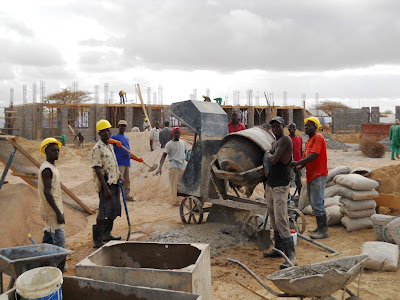Early the following morning, September 30, we took a European Union sponsored flight through Garissa to Dadaab. Dadaab is a small ethnic Somali town about 90 kilometers from Kenya's eastern border. In the early 1990s a camp for refugees from Somalia was established that was projected to accommodate approximately 90,000 people. Today, twenty years later, there are three camps that together shelter about 470,000 people. With more than 1,000 new refugees arriving each day, that number is expected to surpass half a million by the end of October. That is more than the population of a number of significant US cities, including Atlanta, Newark and St. Louis. The massive influx of refugees is a result of protracted internal political instability combined with the current famine gripping parts of East Africa, the worst - some say - in 60 years. Many refugees arrive after walking for days without food and water, and having passed through danger and death. The stories are horrific. It is incomprehensible to grasp the magnitude of the anguish and trauma of each refugee multiplied by 500,000. It is the largest and most intense humanitarian crisis situation in the world. (Click here for an informative article on Dadaab in the UK Telegraph.)
 |
| The market in the center of Dadaab town (above and below). |
One of the most overwhelming impressions are the endless acres of tents and makeshift huts on the outskirts of the camps - thousands and thousands of them. New arrivals temporarily settle there in makeshift dwellings until more permanent locations can be assigned them. The refugees are eventually given a lot in a block, and those who have been around for a while often build houses of mud bricks with corrugated sheet metal roofs.
We were only able to leave the NGO compound in Dadaab town in a vehicle, accompanied by staff and escorted by police when travelling between camps (car-jackings and kidnappings of drivers and passengers are real possibilities ), so our direct contact with the refugees was somewhat limited. Still I was amazed by the openness and friendliness of the refugees, especially the children - who are often the ambassadors of friendship.
Our visit was specifically to observe the works of AVSI (Association of Volunteers in International Service), an NGO (non-governmental organization) that originated from the Church movement Communion and Liberation (CL). Many of my CL friends in Nairobi work for AVSI, including Leo Capobianco, the country director. It was through Leo that our trip was arranged. AVSI has been working in the camps since 2009, and during that time has renovated and rehabilitated all the schools in the camps. As more refugees flood in, the need for schools increase. To accommodate the thousands of new refugee children, temporary classrooms (such as the one below) are set up until more permanent buildings can be constructed.
One of AVSI's current projects is the construction of three libraries (such as the one above) for existing schools. One of the co-sponsors of the project is the US Embassy in Kenya, which will provide solar panels, computers and books. Another project involves the construction of an entirely new school complex (the two photos below), including classrooms, offices, a kitchen and bathrooms.
In addition to physical improvements, AVSI has also undertaken the responsibility of recruiting and training teachers. Refugees who have completed secondary school receive further teacher training from lecturers from Mount Kenya university, as well as workshops on the method of education proposed by Monsignor Luigi Giussani, founder of CL. We had the opportunity to visit one of the sites (below) where AVSI teacher training takes place. Even with all the efforts to improve the education in the camps, the situation is still daunting: a 90 to 1 student:teacher ratio, only one textbook for every six students, and pupils having to sit on the floor due to a lack of desks and chairs. And yet in the midst of this challenging reality, AVSI has made a significant contribution that looks to the future of the children in the camps. I was very impressed with some of the older secondary students we met. They were bright, spoke English well, and were eager to learn. Some had even formed a "future writers club" to encourage one another in their efforts. (Click here to find out more about AVSI's work in Dadaab and how to contribute.)
On Sunday I was very grateful to be able to hear confessions and celebrate Mass for Catholic NGO workers in a small chapel on the grounds of the police post in Dadaab town. Though the congregation meets twice a week, they usually don't have a priest to celebrate the Sacraments for them. They were very grateful for our presence and extremely attentive and responsive at Mass. The Gospel that Sunday was the parable of the workers in the vineyard, and I reflected with them about how God has in some way entrusted to them the refugee seedlings that were uprooted from their own devastated vineyard and transplanted in Dadaab, which becomes their own opportunity to make a return to the Lord from the vineyard of their own lives.


















No comments:
Post a Comment